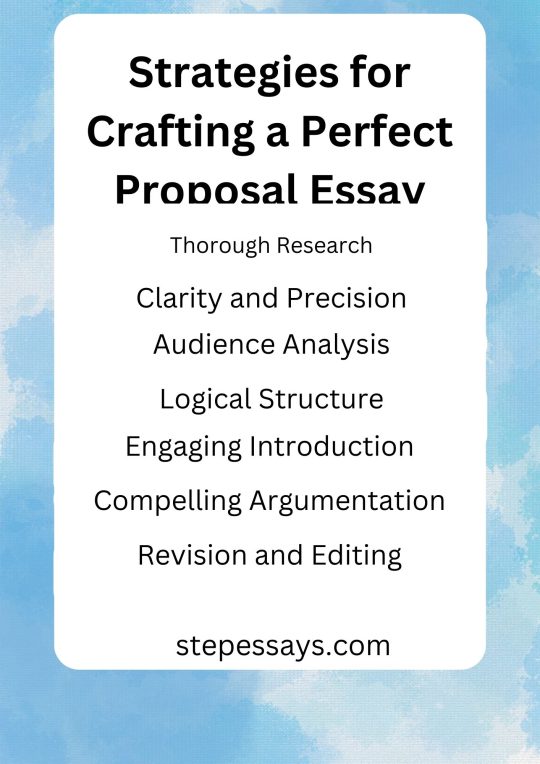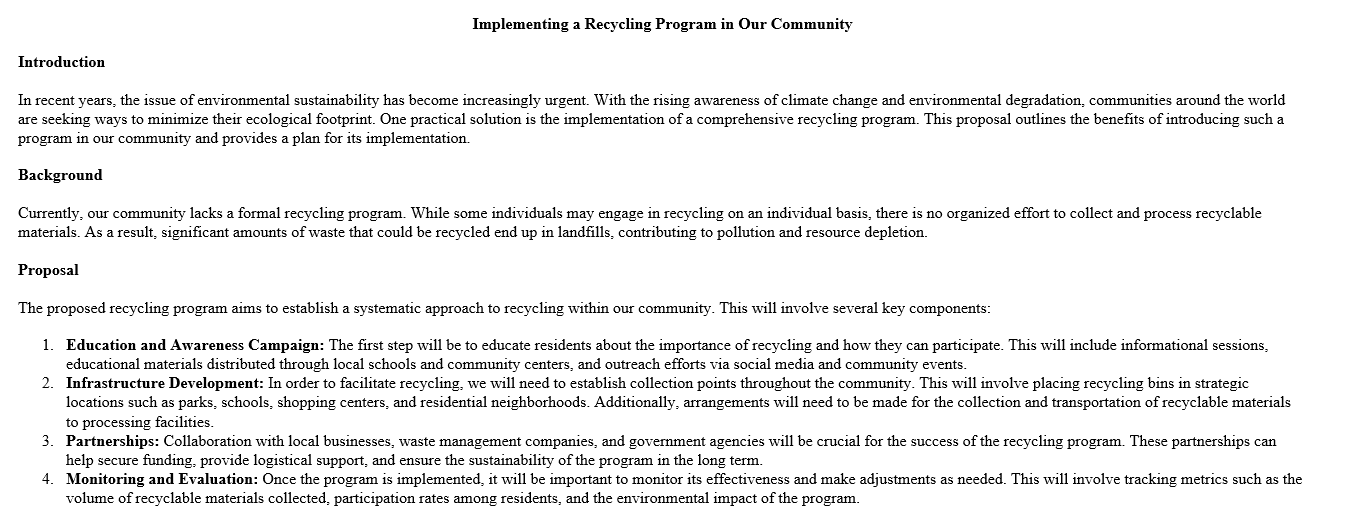Introduction:
Proposal essays serve as a pivotal point in academic and professional spheres, where ideas are not only presented but also advocated for. Whether in the field of academia, business, or public policy, the ability to craft a compelling proposal is indispensable. A perfect proposal essay covers the essence of a persuasive argument, backed by thorough research and a clear plan of action. In this essay, we will look into the steps of writing a perfect proposal, exploring the essential components, strategies, and techniques to captivate the audience and effectuate change.

Proposal Essay
Understanding the Proposal Essay:
Before looking into the process of crafting a perfect proposal essay, it is important to understand its fundamental essence. A proposal essay aims to propose a solution to a problem, advocate for a particular course of action, or persuade the audience to adopt a certain viewpoint. Whether solicited or unsolicited, proposal essays are prevalent across various domains, including academia, business, and government.
The purpose of a proposal essay is multifaceted, encompassing various objectives and goals depending on the context in which it is written. Broadly speaking, the primary purpose of a proposal essay is to propose a solution to a problem, advocate for a particular course of action, or persuade the audience to adopt a specific viewpoint or initiative. Let’s look deeper into the key purposes of a proposal essay:
- Identifying and Addressing Issues: Proposal essays serve as vehicles for identifying and addressing societal, academic, professional, or personal issues. They provide a platform for discussing problems, challenges, or gaps in knowledge or practice.
- Proposing Solutions: One of the central purposes of a proposal essay is to offer solutions or remedies to the identified problems or challenges. Whether it’s suggesting policy changes, implementing new strategies, or advocating for specific actions, proposal essays aim to present viable solutions that can effectively address the issue at hand.
- Advocacy and Persuasion: Proposal essays are inherently persuasive in nature. They aim to convince the audience—whether it’s policymakers, stakeholders, academic peers, or the general public—of the merit, feasibility, and urgency of the proposed solution. Persuasive techniques such as logical reasoning, evidence-based arguments, emotional appeal, and rhetorical strategies are employed to sway the audience’s opinion and garner support for the proposal.
- Generating Discussion and Debate: Proposal essays stimulate discussion, debate, and critical thinking about important issues. By presenting alternative perspectives, exploring different solutions, and engaging with counterarguments, proposal essays foster intellectual discourse and encourage readers to critically evaluate the proposed ideas.
- Informing Decision-Making: In many contexts, proposal essays play a crucial role in informing decision-making processes. For instance, in academic research, a research proposal outlines the methodology, objectives, and significance of a study, guiding reviewers or funding agencies in determining its scholarly merit. Similarly, policy proposals provide policymakers with evidence-based recommendations for addressing societal challenges or enacting legislative changes.
- Seeking Support or Funding: Proposal essays often serve as tools for seeking support, endorsement, or funding for projects, initiatives, or research endeavors. Whether it’s applying for research grants, securing sponsorship for a community project, or soliciting investment for a business venture, a well-crafted proposal essay can attract the attention and support of potential stakeholders, donors, or investors.
- Driving Change and Innovation: Ultimately, the overarching purpose of a proposal essay is to drive positive change and innovation. By advocating for progressive ideas, innovative solutions, and evidence-based practices, proposal essays contribute to societal progress, academic advancement, and organizational development.
Key Components of a Perfect Proposal Essay:

Proposal Essay
Introduction
Problem Statement
The problem statement is a cornerstone of a perfect proposal essay, as it serves as the catalyst for the proposed solution. It articulates the core issue or challenge that the proposal aims to address, providing clarity and focus to the reader. A well-crafted problem statement concisely defines the problem, explores its significance and urgency, and presents its implications for relevant stakeholders. By clearly identifying the problem, the proposal establishes a sense of purpose and relevance, compelling the reader to acknowledge the need for action.
Moreover, the problem statement serves as a guiding beacon throughout the essay, directing the reader’s attention to the specific issue at hand and framing the subsequent analysis and discussion. Thus, in a perfect proposal essay, the problem statement functions as a pivotal component that not only presents the problem but also sets the stage for the proposed solution and underscores the importance of addressing the issue effectively.
Objectives
Objectives serve as a vital cornerstone in crafting a perfect proposal essay, providing both the writer and the reader with a clear understanding of the intended goals and outcomes. These objectives outline the specific aims and targets that the proposal seeks to accomplish, serving as a roadmap for the proposed solution. In essence, they act as guiding principles, directing the focus of the essay and ensuring that all subsequent discussions and analyses are aligned with the overarching purpose.
Well-defined objectives are characterized by their specificity, measurability, achievability, relevance, and time-bound nature, ensuring clarity and feasibility. By articulating precise objectives, the proposal essay not only establishes a sense of purpose and direction but also facilitates evaluation and accountability, enabling stakeholders to assess the effectiveness and impact of the proposed solution. Thus, objectives are fundamental components of a perfect proposal essay, providing a structured framework for action and enhancing the overall clarity, coherence, and impact of the argument presented.
Methodology
Proposal or Solution
Justification
Timeline and Budget
Conclusion
The conclusion serves as a pivotal component of a perfect proposal essay, covering the key arguments, insights, and recommendations presented throughout the essay. It offers effective summary of the proposal’s main points, reiterating the significance of the problem addressed and the proposed solution. In addition to summarizing the main arguments, the conclusion emphasizes the potential impact and benefits of implementing the proposed solution, underscoring its importance and urgency.
Moreover, the conclusion may also offer insights into future directions or areas for further research, encouraging ongoing dialogue and exploration of the topic. By providing a clear and compelling conclusion, the proposal essay leaves a lasting impression on the reader, reinforcing the validity and relevance of the proposed solution and inspiring action and advocacy. Thus, the conclusion plays a vital role in consolidating the proposal’s key messages and motivating stakeholders to support and implement the proposed solution, thereby maximizing its impact and effectiveness.
-
Choosing a Topic
Research and analysis form the bedrock of a well-crafted proposal essay, providing the empirical foundation upon which the proposed solution is built. Once a topic is selected, conducting thorough research becomes imperative. Employing a diverse array of sources, ranging from academic journals and books to reputable websites and expert opinions, ensures a comprehensive understanding of the issue at hand. A critical step in the research process involves conducting a literature review, which delves into existing scholarship to elucidate the background of the issue and identify previous proposals and solutions.
Additionally, gathering empirical evidence, statistics, and case studies further substantiates the proposal’s argument, lending it credibility and depth. Moreover, stakeholder analysis plays a pivotal role in understanding the perspectives and interests of those affected by the issue, thereby informing the proposal’s approach and ensuring its relevance and effectiveness. By meticulously conducting research and analysis, the proposal essay is fortified with robust evidence and insights, enhancing its persuasiveness and impact.
-
Developing the Proposal
Developing the proposal is a crucial phase in the process of crafting a persuasive proposal essay, as it delineates the specific actions and strategies aimed at addressing the identified problem. To develop the proposal effectively, several key elements must be considered. Firstly, stating the objective of the proposal is essential; clearly articulating what you aim to achieve ensures focus and coherence throughout the proposal. Next, outlining the methodology is paramount; detailing the methods or strategies you will employ to address the problem provides transparency and clarity on the proposed approach.
Additionally, providing a detailed implementation plan is crucial; specifying timelines, resources required, and potential challenges ensures feasibility and accountability in executing the proposed solution. Finally, justifying the proposal is imperative; substantiating why your proposal is the most effective solution to the problem based on evidence and reasoning enhances its credibility and persuasiveness. By integrating these elements into the proposal development process, the proposal essay is fortified with a robust framework for action, ensuring its effectiveness and impact in addressing the identified problem.
Effective structuring is essential for clarity and coherence in your proposal essay. Follow a logical structure that guides the reader through the problem, your proposal, and its justification. A typical structure for a proposal essay includes:
- Introduction: Provide an overview of the issue and introduce your proposal.
- Background: Present relevant background information and context for the problem.
- Problem Statement: Define the problem and its significance.
- Proposal: Outline your proposal and the rationale behind it.
- Implementation Plan: Detail the steps required to implement your proposal.
- Justification: Provide evidence and reasoning to support the feasibility and effectiveness of your proposal.
- Conclusion: Summarize the key points and reiterate the importance of your proposal.
Strategies for Crafting a Perfect Proposal Essay:

Proposal Essay
- Thorough Research: A well-researched proposal essay is founded on a solid empirical foundation. Conduct comprehensive research to gather relevant data, statistics, case studies, and scholarly literature to support your arguments and proposals.
- Clarity and Precision: Clear and concise writing is paramount in proposal essays. Avoid ambiguity and jargon, opting instead for straightforward language that resonates with the target audience.
- Audience Analysis: Tailor your proposal to the specific needs, interests, and preferences of your target audience. Understanding their perspectives and concerns enables you to craft a more persuasive and compelling proposal.
- Logical Structure: Organize your proposal essay in a logical and coherent manner, with each section flowing seamlessly into the next. Use headings, subheadings, and bullet points to enhance readability and comprehension.
- Engaging Introduction: Grab the reader’s attention from the outset with an engaging introduction that piques their curiosity and motivates them to delve further into the proposal.
- Compelling Argumentation: Build a persuasive argument by presenting compelling evidence, logical reasoning, and persuasive rhetoric to support your proposal. Anticipate potential counterarguments and address them preemptively to bolster your case.
- Visual Aids: Incorporate visual aids such as charts, graphs, tables, and images to enhance the presentation of data and statistics. Visual elements not only add aesthetic appeal but also facilitate comprehension and retention of information.
- Revision and Editing: Thoroughly revise and edit your proposal essay to ensure clarity, coherence, and precision. Pay attention to grammar, punctuation, and syntax, and seek feedback from peers or mentors to refine your writing further.
Conclusion:
In conclusion, crafting a perfect proposal essay necessitates meticulous planning, thorough research, and persuasive argumentation. By adhering to the key components and strategies outlined in this essay, aspiring writers can master the art of proposal writing and effectuate meaningful change in their respective fields. Whether advocating for a policy change, proposing a business venture, or initiating a research project, the ability to articulate compelling proposals is an invaluable skill with far-reaching implications. As we navigate the complexities of the modern world, the power of a well-crafted proposal essay remains unparalleled in shaping discourse, influencing decisions, and driving positive transformation.
An Example of Proposal Essay


